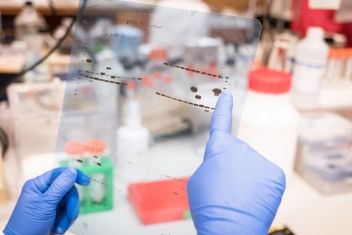Western Blot Analysis
Western blotting is a widely used analytical laboratory technique that is used in molecular biology to detect proteins within a mixture.
During a western blot experiment, samples containing a mixture of proteins are separated based on their size using gel electrophoresis. Although commonly used as a qualitative method to detect and identify proteins, western blotting can also be used semi-quantitatively.
Western Blotting Resources
Protein Separation
Sample preparation is the first stage of protein separation using the western blot method.
The number and complexity of the steps involved will vary based on the sample type and the complexity of the protein mixture.
However, there are two main steps involved with separating any mixture of proteins within a sample.
Protein Extraction
Methods required to extract proteins from samples will range in complexity. Common methods used to extract proteins from a sample include both physical and chemical processes, including sonication, homogenization or denaturation.
Measuring the total protein concentration of samples is also important, as it will impact the quality of results from electrophoresis and detection stages.
Gel Electrophoresis
Separation of proteins is performed by loading prepared samples to the gel and applying an electric field.
The protein mixture is then separated, based on chemical and physical properties of the molecule. This separation forms distinct bands on the gel for further analysis.

Protocols
Our western blot protocols help to guide you through your next experiment.
Related Applications
Protein Transfer
After separating a mixture of proteins, the resulting protein bands must be transferred to a membrane to allow for further preparation stages.
Transfer to a Membrane
The separated proteins must then be transferred to the membrane.
It is important to choose the correct membrane material for the analysis, with popular options including nitrocellulose and PVDF. This will vary on whether you opt to use a wet or semi-dry blotting method. This will also impact the requirements of the buffer solution that will be required.
Blocking non specific sites
Once transferred, a blocking reagent is required to prevent non-specific protein binding. Careful considerations must be made when determining which antigen-antibody interactions to block with regards to your target protein.
Protein Detection
After separating, transferring and preparing the antigen-antibody sites, the use of primary and secondary antibodies allows for identification and detection of the target proteins.
Primary and Secondary Antibodies
Prepared protein samples are then treated with a primary antibody. This antibody creates a specific binding to the target protein. Further treatment may be required with a secondary antibody, which binds to the primary antibody and aids in detection.
Detection Methods
The choice of secondary antibody that is used for western blotting methods, will determine the detection method required. Utilizing chemical properties of the antibody - such as chemifluorescence or chemiluminescence - target proteins can be identified, and sometimes quantified.
Western Blot FAQs
All of Bethyl's antibodies are tested using the reagents from the ReliaBLOT® kit. A ReliaBLOT protocol and western blot protocol can be found in the Protocols Section of the Bethyl website.
The recipe for ReliaBLOT® blocking buffer is proprietary. An acceptable substitute would be 5% milk (Carnation, non-fat, dry)/TBS/0.5% tween. A protocol for Western Blotting can be found in the Protocols Section of the Bethyl website.
The sequences of the immunogens are proprietary. All of the data sheets on our polyclonal antibodies provide a range of amino acids in the protein to which the peptide maps.
-
- The migration patterns of molecular weight markers can differ between vendors.
- The type of gel and buffer system used can have effects on protein mobility.
-
- Proteins that are highly basic or acidic (charged) may not migrate at their theoretical molecular weight.
- Sometimes proteins will retain some secondary structure (re-folding) which can alter mobility.
- Post-translational modifications will alter protein mobility.
By clicking “Acknowledge”, you consent to our website's use of cookies to give you the most relevant experience by remembering your preferences and to analyze our website traffic.
